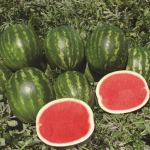Imagine a hot summer’s day. You’re out with your family swimming in the pool. You come to the surface for a breath of air and catch a glimpse of your mother walking towards you carrying a large green object. Possibly the best summer treat in all of Florida: a watermelon.
 As winter begins to settle in and the cooler night’s approach, many of us would believe that farming is over for the year. That all production is over until the spring. However, for watermelon farmers the season is only beginning. Growing watermelons is an eight-month process from cultivation of the soil to cultivation of the plants back into the soil.
As winter begins to settle in and the cooler night’s approach, many of us would believe that farming is over for the year. That all production is over until the spring. However, for watermelon farmers the season is only beginning. Growing watermelons is an eight-month process from cultivation of the soil to cultivation of the plants back into the soil.
During the month of December, farmers are beginning the long thorough process of preparing the ground for  planting. They have to cultivate the land several times to ensure that the land is clear and level and nutrients are brought to the top of the soil. Once the land is ready, farmers then rotovate beds and apply plastic on them to hold the plants. Under the plastic is a plastic tube that is a form of drip irrigation to supply the plant with water and fertilizer. Finally, when the nights get above freezing temperatures at the end of February or early March, they are ready to plant watermelon plants that are a few inches tall. Cultivating the land is not just about plowing up dirt, it’s a sign of new beginnings for the farmer. It’s a promise of a better year in store for them.
planting. They have to cultivate the land several times to ensure that the land is clear and level and nutrients are brought to the top of the soil. Once the land is ready, farmers then rotovate beds and apply plastic on them to hold the plants. Under the plastic is a plastic tube that is a form of drip irrigation to supply the plant with water and fertilizer. Finally, when the nights get above freezing temperatures at the end of February or early March, they are ready to plant watermelon plants that are a few inches tall. Cultivating the land is not just about plowing up dirt, it’s a sign of new beginnings for the farmer. It’s a promise of a better year in store for them.
Growing up working on my uncle’s farm growing watermelons has taught me so much about what work goes into creating our food. There are countless hours spent in the fields caring for the crop. It’s not about the GMO’s or pesticides being used on a crop, it’s the love and care a farmer uses when tending to their crop. The money a farmer makes off of their crop is all that they get for the whole year. It’s not like a normal job where you get paid monthly. Farmers get one paycheck for their crops and they have to gamble their livelihood on the success of them. With so much on the line, they have to put all of their effort into making a successful crop to contribute to feeding the predicted global population of nine billion people by 2050.
are countless hours spent in the fields caring for the crop. It’s not about the GMO’s or pesticides being used on a crop, it’s the love and care a farmer uses when tending to their crop. The money a farmer makes off of their crop is all that they get for the whole year. It’s not like a normal job where you get paid monthly. Farmers get one paycheck for their crops and they have to gamble their livelihood on the success of them. With so much on the line, they have to put all of their effort into making a successful crop to contribute to feeding the predicted global population of nine billion people by 2050.
As FFA members it is our job to be advocates for agriculture. We must learn from the agriculturalists in our community and take that knowledge and share it with those around us whether it may be citrus, strawberries, beef, or in my case watermelons. The next time you enjoy a sweet, juicy, and crunchy watermelon, remember to thank a farmer for the long months of work that went into producing it.
Forever blue,
Brooks Parrish
State President

